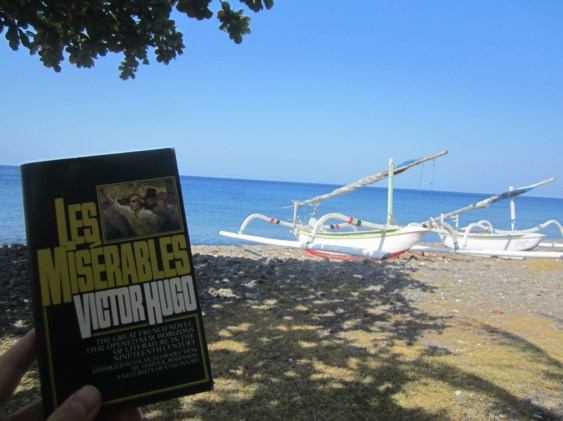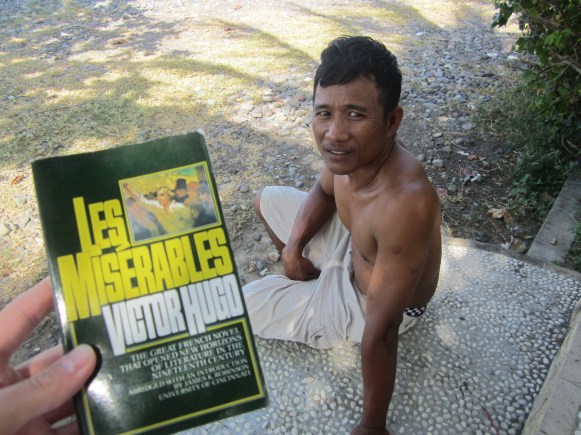My rating: 5 of 5 stars
Les Misérables (1862) by Victor Hugo was originally some 1,200 pages at publication, but the modern ”abridged” version that I read was published in 1982 at a lean, precise 400 pages.

The editor makes his remark on the excision of some 800 pages from the classic: ”What is chiefly lost is the novel of ideas, the novel which treats a number of the central problems and interests of nineteenth century France. What remains is a novel of character and action in much clearer outline. Even when the novel was first published discerning critics noted that for all the novel’s power it was diffuse and wordy” (In Introduction, pg ix-x). In other words, in the abridged form of Les Misérables the reader has a more modern novel.

Regardless of more modern tastes by the editors, the character of Jean Valjean is as vivid and memorable as ever and is someone to remember for all ages. The reading is swift and the story is never sagged down by excessive facts or commentary that so many of the classics have, and this is much to do with the abridged version as anything else. Immediately the reader knows that they are in the hands of a master storyteller.

Hugo writes of Valjean: ”He beheld his life, and it seemed to him horrible; his soul, and it seemed to him frightful. There was, however, a softened light upon that life and upon that soul. It seemed to him that he was looking upon Satan by the light of Paradise” (p 38).
Of Cosette, the deft hand of the writer describes her as thus: ”In the place she was called The Lark. People like figurative names and were pleased thus to name this little being, not larger than a bird, trembling, frightened, and shivering, awake every morning first of all in the house and the village. Only the poor lark never sang” (p 47).

What a powerful last line!
Most everyone knows the plot, but if you happen to have missed this great story it is quite simple.
Jean Valjean is released from prison after 19 years (he stole a loaf of bread and tried to escape several times which lengthened his sentence). He cannot find work. He is no longer accepted into society. He even steals from a kind bishop. The Bishop, however, forgives him and gives Valjean the silver in exchange for the man to do good in the world. Valjean takes the silver, evades the parol officers, and vanishes.

Almost two decades later, Valjean is the owner of a successful business and becomes a mayor. All would be well if not for the hungry eyes of the law. Valjean’s antagonist is Javert, a truly splendid villain if ever there was one. Here we have Hugo’s unique perception of inverting the hero and villain. In Hugo’s story the villain is the police officer (which is usually viewed in society as a hero) and the hero of Hugo’s story is Valjean (an ex-con, which convicts are often seen as the villain). The genius of Hugo’s mind does not stop there.
Valjean, in order to save another man’s life, admits his true identity to a very shocked court.
”It was evident that Jean Valjean was before their eyes. That fact shone forth. The appearance of this man had been enough fully to clear up the case, so obscure a moment before. Without need of any further explanation, the multitude, as by a sort of electric revelation, comprehended instantly, and at a single glance, this simple and magnificent story of a man giving himself up that another might not be condemned in his place. The details, the hesitation, the slight reluctance possible were lost in this immense, luminous fact… He went out, and the door closed as it had opened, for those who do deeds sovereignly great are always sure of being served by somebody in the multitude” (p 93-94).

Valjean is later arrested by Javert, but not before Valjean is able to bury his fortune in the woods. Valjean is in prison and saves a man from dying, but then escapes by jumping into the sea. The police believe Valjean dead.
Valjean escapes, retrieves his fortune, and adopts Cosette, whose mother had died and willed Valjean to care for her daughter.

Once the girl is grown, she falls in love with a young man named Marius. Marius is later caught up in the French Revolution, and is shot in a skirmish. Valjean saves Marius and takes the young man to his grandfather’s house. Eventually, Marius marries Cosette.
Valjean, out of guilt, confesses to Marius who he really is and that he must not share in Cosette’s happiness any longer. Any moment the law could come arrest Valjean, bringing shame to Marius and his entire household.
”From what motive, indeed, does this convict come and say: I am a convict? Well, yes! the motive is strange. It is from honor. I could have lied, it is true, have deceived you all, have remained Monsieur Fauchelevent. As long as it was for her, I could lie; but now it would be for myself, I must not do it. It was enough to remain silent, it is true, and everything would continue. You ask me what forces me to speak? a strange thing; my conscience” (p 362). ‘
Marius rebukes Valjean, while Marius still does not know who saved him from the battle. Valjean, however, responds by giving his fortune to Cosette and her new husband, Marius.
Valjean, ostracized, grows weak. His fatherly love for Cosette and the absence they now share is too much for him. Valjean begins to die. Then, Marius discovers the truth behind Valjean’s honor and how the old man saved him and together with Cosette Marius find Valjean at the brink of death.
Valjean: ”No; God thought as you and I did, and he has not changed his mind; it is best that I should go away. Death is a good arrangement. God knows better than we do what we need” (p 395).

The abridged version ends slightly different than the original but I think it is nevertheless a remarkable ending and stops when it should stop:
”This stone is entirely blank. The only thought in cutting it was of the essentials of the grave, and there was no other care than to make this stone long enough and narrow enough to cover a man. No name can be read there” (p 400).
Whether you decide to pick up the original 1,200 page volume or the swift and sharp 400 page version of Les Misérables, it will always be a strong and worthy recommend.
Related articles:
- Les Miserable (shanemykim.wordpress.com)
- Les Misérables (poupireviews.wordpress.com)
- Photo Flash: LES MISERABLES Raises the Barricade in Toronto; First Look at Ramin Karimloo, Earl Carpenter & More on Stage! (broadwayworld.com)
- Les Misérables (jessicameaden.wordpress.com)
- Les Misérables (as told by the Daily Mail) (dacreclassics.wordpress.com)
- Les Miz returns with stellar new staging, design (lfpress.com)
- Les Misérables superbly revised: review (thestar.com)
- Review: Karimloo shines as Valjean in ‘Les Mis’ (metronews.ca)
- Review of Les Miserable! (queenslogic.com)
- Australian Production Of Les Misérables Announce Cast (noise11.com)















http://jessicameaden.wordpress.com/2013/10/10/les-miserables/
Pingback: ugg bottes cuir
These are in fact enormous ideas in about blogging.
You have touched some nice things here. Any way keep up wrinting.
Asking questions are genuinely pleasant thing if you are not understanding something totally, but this paragraph presents pleasant understanding yet.
This paragraph presents clear idea designed for the new visitors of blogging,
that actually how to do blogging and site-building.
Hey I know this is off topic but I was wondering if you knew of
any widgets I could add to my blog that automatically tweet my newest twitter updates.
I’ve been looking for a plug-in like this for quite some time and was
hoping maybe you would have some experience with something like this.
Please let me know if you run into anything. I truly enjoy reading your blog and I look forward to
your new updates.
Good day! This is kind of off topic but I need some advice from an established
blog. Is it hard to set up your own blog? I’m not very techincal but
I can figure things out pretty quick. I’m thinking about
creating my own but I’m not sure where to start.
Do you have any tips or suggestions? Thanks
thank you for share!
nice articles
Very nice blog post. I absolutely love this site. Keep writing!
Pingback: Do Not Say We Have Nothing (2016) by Madeleine Thien & the Book of Records - CG FEWSTON